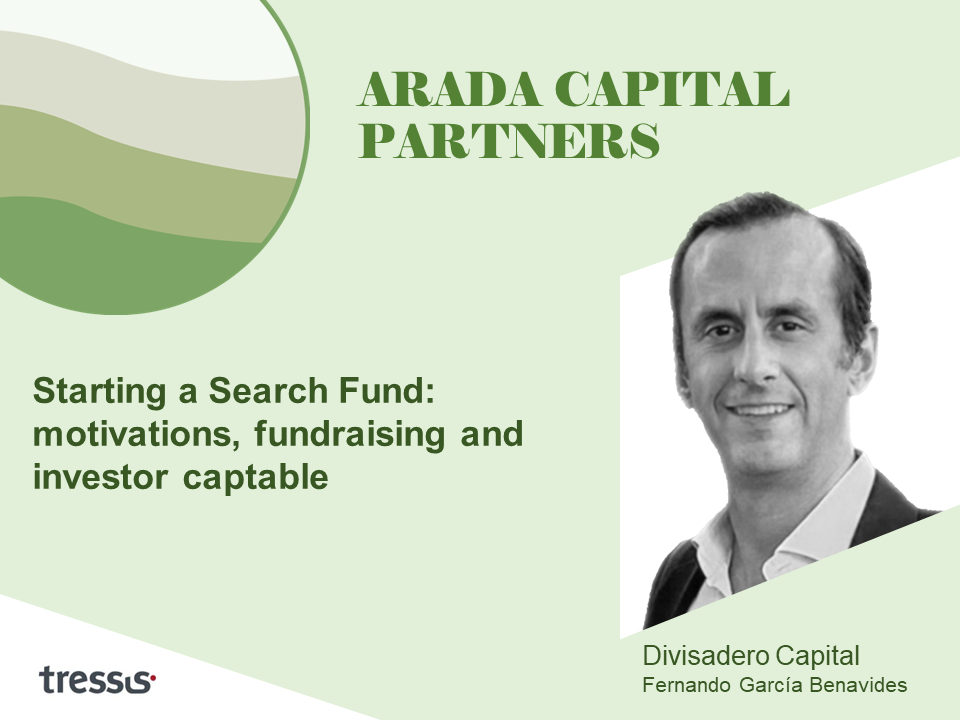Starting a Search Fund: motivations, fundraising and investor captable

December 22, 2023
by an investor from IESE Business School in Calle de Núñez de Balboa, 120, 28006 Madrid, España
Discover the interview conducted by the Arada Capital Partners team with Fernando García Benavides, the entrepreneur leading Divisadero Capital, a Search Fund based in Spain. In this conversation, we delve into Fernando's fundraisin journey as he embarks on the search phase.

What do you believe are the correct motivations that an entrepreneur should have to launch a Search Fund? In your case, what drove you to undertake entrepreneurship through acquisition?
Fernando: The right motivations for launching a Search Fund, in my view, are a trifecta of ambition, curiosity, and a keen interest in operational leadership. Firstly, there’s the ambition to helm a business, not just to start from scratch but to steer an existing entity to new heights, finding fresh opportunities and growth, and blending entrepreneurial spirit with practical execution.
Secondly, curiosity is key. You’re diving into established businesses, industries, perhaps even markets you’re not initially familiar with. This demands a voracious appetite for learning and an ability to quickly understand and adapt to new business landscapes.
Lastly, a genuine interest in fostering a positive organizational culture and building strong teams is vital. The success of a Search Fund often hinges on the ability to inspire and lead a team effectively, nurturing talent and driving collective success.
My journey towards entrepreneurship through acquisition was driven primarily by the sense of ownership that a Search Fund brings. It offers more than just equity, it’s more about being in charge from start to finish, leading the project, and making key decisions, and I find it very compelling.
Another crucial aspect for me was acknowledging that personal and professional growth has come mostly from pushing myself into new challenging environments. There is a certain excitement in stepping out of my comfort zone and continuing to learn about businesses and teams.
Along these lines, I’ve had the privilege of exploring various facets of companies, each intriguing in their own way, however leading multidisciplinary teams is where I found my true calling. It’s this blend of leadership, learning, and complete ownership that drives my passion for entrepreneurship through acquisition.
How did you approach the fundraising process? What strategy did you follow to raise the search capital?
F: Approaching the fundraising process for a Search Fund requires thorough preparation and a clear strategy. The first step is to gain a deep understanding of the Search Fund model. This means delving into its structure, incentives, and the nuances of what works and what doesn’t. It’s essential to determine if this path aligns with your commitment and career goals, especially considering the real risk of failure and the need for honest self-assessment about the challenges ahead.
Fortunately there are many resources available that helped me solidify my understanding of Search Funds. There are plenty of online resources at your disposal but I would particularly highlight searchfunder.com, and of course going through the Search Fund bible: the Stanford Search Fund primer. There are also a few podcasts that provide valuable insights into the practical aspects of this model, I particularly like Search Funded, and In the Trenches.
Another useful way of becoming comfortable with the model is by speaking with as many searchers as you possibly can, both successful and unsuccessful. I’m very grateful to this community for having helped me during my research, for their candid advice and their warmth along the process. Even now I continue to leverage the searcher network.
Only after this groundwork was completed I began drafting my Private Placement Memorandum (PPM) which is the document you introduce to investors to present your case. The document is fairly standard but there are three sections in particular that require thorough attention: the first one is the About Me section, in which you succinctly explain who you are, what motivates you, and your professional experience. The second, is the areas of focus, in which you should expand on certain verticals or industries that are particularly appealing to you. Finally, it’s important to go through the costs section, to think about how you want to invest the funds during the search process.
Having completed this preparatory work, I was in a strong position to understand my own value proposition, and it enabled clarity to craft an engaging and persuasive pitch to investors. Ideally the pitch should encapsulate who you are, your purpose, areas of interest, your strengths —and weaknesses!, and your search strategy.
What helped you the most in the fundraising phase, and what were the main challenges you encountered?
F: I was fortunate to have the guidance of a couple of mentors throughout this process. Their insights and advice were invaluable and I strongly recommend anyone embarking on this path to seek out mentors. Their experience and perspective were a guiding light in navigating the complexities of the fundraising process.
Following their recommendation, I spoke with as many searchers as possible, local and international, to get their perspective on their journey. Although every search is unique, I was able to find certain patterns that helped me undertake the fundraising process with confidence.
As for challenges, while my journey was relatively smooth, I recognize that this isn’t always the case in such ventures. Common hurdles often include aligning investor expectations with the realities of the search fund model, navigating the competitive landscape for funding, and effectively communicating one’s unique value proposition in a crowded market. I was prepared to face these challenges, thanks to the groundwork laid by my mentors and the insights gained from other searchers. This preparation turned potential challenges into manageable aspects of the process.
You have a balanced cap table between institutional and private investors? What were you looking for in investors? What were the characteristics of your ideal cap table?
F: Every searcher’s journey is unique, and the composition of the cap table that suits one might not suit another. For me, there were three key aspects I focused on while shaping my ideal cap table: geography, background, and personal fit.
In terms of geography, I sought a mix of investors from diverse regions: I wanted to benefit from the knowledge of local investors who are well versed in the Spanish ecosystem and idiosyncrasy, the expertise and tenure of American investors who have seen it all and done it all, and the insights and connections of other international investors across different markets and cultural landscapes. A geographically diverse cap table can offer a wealth of knowledge and networking opportunities crucial for global business expansion.
Regarding background, I looked for investors with a variety of professional experiences and industry expertise. There were two aspects in particular that I aimed for: first, investors with a strong financial background that could complement my operational expertise. Second, having former searchers that have lived through the Search Fund process, and could add value when facing uncertainties.
Finally, personal fit was paramount. It’s essential to have investors who share your vision and values, and with whom you can build a relationship based on trust and mutual respect. The right personal fit means having investors who are not just funding sources but true partners in the journey. They should be individuals who understand the entrepreneurial journey’s ups and downs and are committed to the long-term success of the venture.
Thus, my ideal cap table was not just about the numbers. It was a carefully curated group of individuals and institutions who form the backbone of a robust, supportive, and dynamic investment team. On this note, Arada stands out as a significant investor, closely aligning with my key criteria. Their global perspective with local knowledge, diverse industry background, and strong financial expertise are bringing invaluable insights and perspectives. Beyond their professional acumen, Arada’s alignment with our long-term vision and core values has been remarkable, making them not just investors but valued partners in our journey.
What will be the strategy you will pursue during the search phase, and how will the relationship with your investors be managed?
F: During the search phase, my strategy will be focused on meticulous market analysis and targeted company evaluations. I’ll be prioritizing businesses that not only fit my investment thesis but also have potential for significant value creation. Efficiency in this process is key, so I’ll be leveraging technology and a data-driven approach to streamline the search. At the moment I’m building a team of interns that will be helping during the process, and I plan on mentoring them in one of their first real world workplace experiences.
As for managing relationships with investors, transparency and regular communication will be my pillars. I plan to keep investors informed through regular updates, ensuring they’re aware of the progress and any pivotal decisions. This open line of communication will not only build trust but also allow for valuable input from investors, leveraging their expertise and insights.
from École Polytechnique de Montréal, Université de Montréal in Montreal, QC, Canada
from University of Maryland in Miami, FL, USA